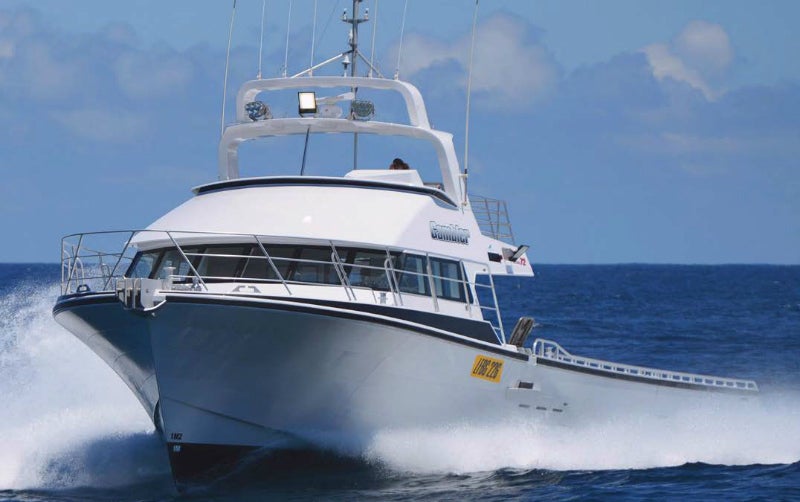
Ian Ralph is a third-generation western rock lobster fisherman with around 30 years in the fishery, so he has seen the good times and the bad times and knows the properties a successful boat needs.
They are not the same properties as in his father’s time. The norm then was a day boat landing bagged lobsters, only the advanced thinkers were fitting live tanks, unable to shift its full quota of pots in one move, and whose most prized property was speed. The antithesis to this norm is Gambler, Ian’s new vessel.
Built in Geraldton by Peter Ellis’s Xtreme Marine, Gambler features endurance, total carrying capacity, live product capacity, habitability and overall economy. She completely fits his operational style, which is pretty much the new norm.
Ian’s home port is Kalbarri at the mouth of the Murchison River, an idyllic spot, but his fishing grounds range from Denham in the north to Dongara in the south, certainly not a range for a day boat. A normal working spell is three pulling days, two nights at sea, then return home. When working deep, those two nights save a huge amount of travel time and a great deal of fuel. Gambler operates around 150 pots, which can be stacked two deep leaving ample working deck area.
“Gambler’s 21.8m measured length is less than the largest of current boats but very large compared with the 90s heyday of building,” commented Southerly Designs’ managing director Andrew Taylor.
Design emphasis had changed from speed to quantity and quality of live catch, and efficiency at most speeds. One vital consideration for Gambler was draught: entry to the homeport is via a notorious bar. The vessel has two driving positions, the wheelhouse and an open fly bridge; the vogue for an elevated wheelhouse has come and gone.
On trials, with full fuel of 7,600l and 6.4t of water, top speed was 26k. At 18k, the typical cruising speed, fuel consumption was 158l per hour. These figures were achieved using a pair of 720kW MTU 8V2000s.
Twins seem a counter economy choice but Ian had sound reasoning, saying: “It makes for easier manoeuvring on the gear, and if you have a breakdown there are less boats out there to help than there used to be. And then there are the cliffs.”
He is speaking of the Zuytdorp cliffs that rise sheer from deep water for much of the coast between Kalbarri and Shark Bay’s South Passage. Break down with an onshore wind and you regret very much having bought only one engine.
The live tanks have a capacity of 2.7t of water and 86 baskets of product, which requires powerful and reliable pumping capacity. The engine room adds a pair of 30kVA three phase gensets to the machinery inventory to power this. Adding to the below deck busyness is a sizeable freezer for the bait.
Gambler was built to 2B as well as 3B survey. Ian was mainly thinking ahead to resale time and the possibility of selling outside the industry. He was also thinking shorter term. There could be charter opportunities for the likes of marine research. Although he fishes with a total crew of three there is sleeping accommodation for six.
At one time the holder of a rock lobster licence was automatically awarded a wet line licence as well. The automatic feature has disappeared but Gambler does have the licence. This gives the option of another fishery when the rock lobster quota has been caught.
Xtreme fitted out the accommodation to the builder’s usual elevated standards. Hailey, Ian’s wife, on first seeing the galley wanted to take it home. The equipment count generally is high: besides several methods of heating and cooking, freezing and refrigerating there is even a washer and a dryer.
One indicator of the attention given to crew comfort is the freshwater capacity of 800l, about 90l per day per person, or 20gal in old money. Luxury indeed compared with only a few years ago, as is the air conditioning. Not just the presence of the cooling but also the sophistication of the equipment producing it.
Every viewer’s opinion of Gambler’s appearance is on the enthusiastic side of favourable. As it should be: Ian planned this boat for two years, and throughout the building process kept track of progress. Builder Peter Ellis, a stickler for accuracy and quality, was more than happy with this. The overall appearance is greatly enhanced by the moulded fibreglass wheelhouse, which is in perfect proportion to the hull.

